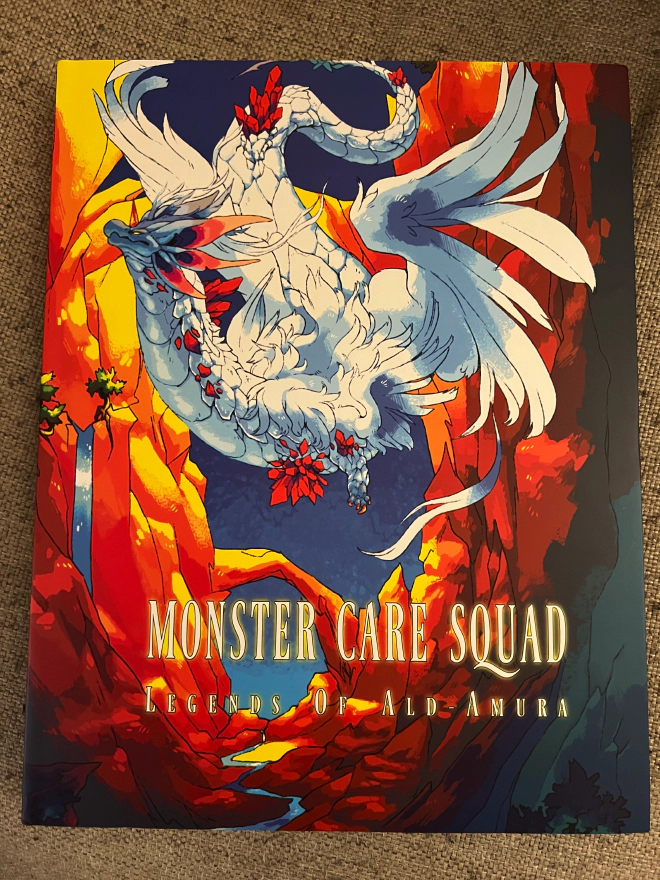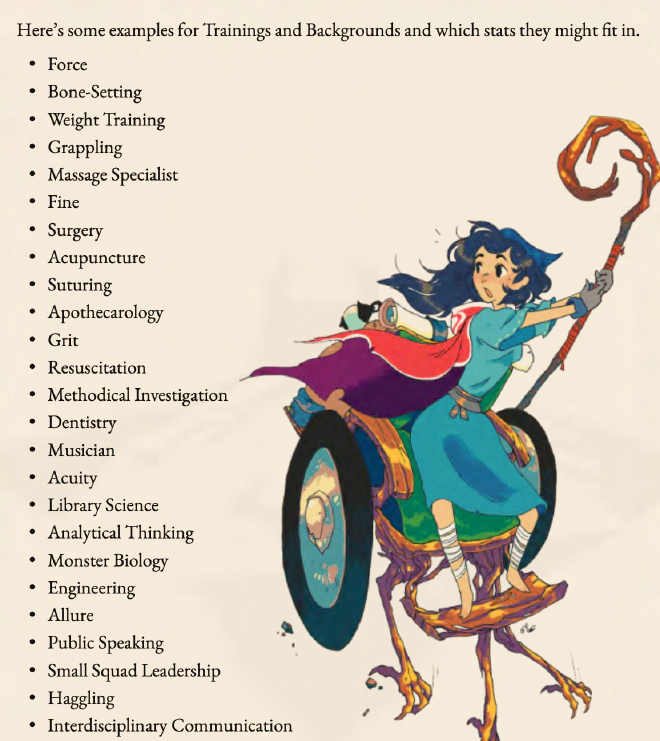I wrote recently about receiving my backer copy of Monster Care Squad, which is a Ghibli-inspired RPG about the people caring for the magical monsters that once protected their communities from a terrible illness. I was thinking of my daughter when I backed the Kickstarter campaign, and as expected, she was immediately enamored by the rule book and read it back to front twice over the week.

She asked to play it, and so I ran it for her on Sunday, and figured it was worth doing a quick review of the experience. I’ll put out a caveat here that I was running this for only one player, so some of the teamwork functions in the rules didn’t come into play.
While she’s played No Thank You, Evil! in the past, this was her first all-ages RPG, and it was so much fun seeing her think both narratively and mechanically at the same time.1
The Concept #
I love the concept of this game. The setting of Ald-Amura is one of infinite kindness, and describes a diverse society based upon mutual respect that is explicitly anti-colonial and anti-capitalist. The land has been without war for over 1000 years, and magical monsters have been protectors and benefactors to humanity, resulting in a symbiotic relationship that benefits all.
Unfortunately, several years ago, a strange illness began spreading across the monsters with highly varied symptoms and progressions that cause them to become destructive. The one constant is the rage inducing pain in the creatures, and the tendency to cause specific colorations of infection sites, which has earned the it the name “False Gold.” It’s left unclear in the book how this started, but there are several options presented as plot threads for GMs/Guides to use in an extended campaign.
Regardless of the cause, humans immediately leapt into action to form the loose association of caretakers called the Monster Care Squad. These Specialists travel the land in search of these ailing monsters and do their best to diagnose and cure them of their Wounds.
To say it is Ghibli-inspired is an understatement. Every aspect of the lore oozes with Miyazaki-like heart and humor. It really is a beautiful game concept, and my daughter, who is deeply kind-hearted and loves all animals immediately vibed with it.
Game Flow #
Since it was our first time playing, it was important that I run it RAW so that I got a good feel of the game as intended by the designers.
Monster Care Squad is heavily influenced by Powered By the Apocalypse for its rules, and honestly, most of the issues I came across seem to arise from their implementation of that, as I think will be evident in some of my specific issues with Moves discussed later below.
Character Creation #
Characters are relatively simple to generate, but the game does suffer from some odd layout choices.2 To begin with, the book does not include the character sheet, which is only available as a download from its Itch.io page. The sheet itself has an odd layout choice where there is only room for one training or background per skill category, which the rules don’t seem to restrict. This made it a bit confusing for us as we were building out characters.
That being said, the character creation process is pretty simple:
- Choose four Trainings and a Background to differentiate your character.
- Assign a standard array of bonuses to your five skills/attributes.
- Create a specialty.
- Pick two Moves as you special abilities.
- Give yourself some equipment.
- Give yourself a name, pronouns, etc.
Again, here we run into some weird layout choices as Trainings are supposed to relate to specific skills, but the list is not indented underneath the skill name, e.g., Force, Fine, which makes it more difficult to parse.

The Guide also creates a character, who serves in the role as a mentor, and has some special abilities to help the other players, which seemed like an unnecessary level of complication for what essentially functions as a GM insert, but in a session with more players it’s possible I might feel differently.
Gameplay #
Gameplay for each session is divided into three phases:
- Diagnosis: Figure out what the monster is, what’s wrong with it, etc.
- Synthesis: Make a plan and concoct a curative.
- Symbiosis: Confront the monster,3 who may be unreasonable due to their pain, and treat them.
Pacing for the first two phases make use of PBtA Clocks, which are an abstract measure of progress towards completion. To make a clock, the GM draws a circle divided into a number of segments that represents how complex they think that phase of play will be. As players takes actions in each phase, certain events will either fill in a segment as a success or a failure, and when the clock is full, you move to the next phase of play. Completing a clock with all successes earns players bonus Aces that they can use later to enhance their rolls.
Most rolls during the first two phases are 2d6+Skill, and a possible bonus if your training or background applies to the situation. You can also spend your earned Aces to get another bonus on your roll, most of which are earned over play. There are some Aces called Character Aces which are one-time bonuses you can apply based on your backgrounds and equipment but they’re only mentioned in passing so you’d be forgiven if you forget they are there at all.4
The exception to this is the Symbiosis phase where there is sort of clock in the sense of the number of Wounds a given monster has from the illness, but it’s handled very differently. In that phase, there is a Control Track which influences which dice type5 a character can roll to attempt to cure, so the more preparation the players put into attempting to cure each wound, the better their chances of success. If the players get pushed past the bottom of the Control Track, the monster’s erratic behavior overpowers them and they must retreat, and start the symbiosis phase over again.
Once a monster is cured, players can take advancements and move onto the next adventure.
Impressions #
There is a lot to love about Monster Care Squad, but I also came away feeling frustrated with it. What follows are my subjective experiences while running the game, both good and bad, and my attempts to understand why I felt that way.
Clocks #
As always with PBtA and FitD games, I really enjoy using Clocks as a pacing mechanism. It’s an easy way for the Guide and the players to easily understand where you are in a given part of the story. They are a really elegant and simple tool for narrative games.
That being said, successfully filling a Clock segment only happens through the application of specific Moves, which means that RAW requires additional checks to complete a segment, even if narratively the player has successfully extracted an important piece of information towards the cure. Given that successfully filling a segment is explicitly specified in the rules, but marking a segment as unsuccessful is not, this creates an odd dynamic where it’s not always clear what’s right to do, and marking a segment as unsuccessful feels like an arbitrary decision the Guide uses to move play along.
Moves #
Moves, in general, are a problem. Some Moves are explicitly taken by the player or GM, and others are triggered by certain narrative events and choices. As with many PBtA games, too many Moves available makes it incredibly difficult for the players and Guide to keep them in working memory. Monster Care Squad attempts to combat this problem by giving each Move a Context, which limits its use to a specific phase of play, with a subset of Moves being available whenever.
And here we come to another weird layout choice. Player Moves are listed in the book in an utterly random order. You will not find them organized by Context or sequenced alphabetically. This is confusing both for character creation and also for keeping which moves are relevant in your head if you need to look them up. Frankly, this is a layout choice I find utterly baffling, and a terrible user experience.
A mechanical element I found frustrating was that while the Moves and their results in the Diagnosis and Symbiosis phases are explicit, Moves in the Synthesis phase provide zero guidance for completing the clock, and it is left entirely to the table to figure out. Given that a lot of care clearly went into the Moves in the other two phases, it feels very hand-wavy and makes the synthesis phase feel a bit like an afterthought.
As I ran the game, I grew more and more frustrated with the Moves in general, and it took a lot of willpower not to just throw them out altogether and just use the Skills and Backgrounds as a framework for rolls and use what was happening in the narrative to determine where we were on a given Clock. While the rules do encourage Guides to improvise if a given Move doesn’t apply, in practice it felt limiting.6 And this may be a challenge with my particular tastes as a gamer. I prefer mechanics to support and influence the narrative, whereas here I felt like the narrative was set-dressing for the mechanics.
You can, just like in any TTRPG, go off on your own, but I feel like if a game goes to the trouble of defining mechanics for a given element of play, I should feel empowered by using them, rather than feeling constrained and bored.
Control Track/Curing Wounds #
I really liked the curing wounds mechanics. There is no combat or concept of harm or stress in Monster Care Squad, and the Control Track is an elegant way of abstracting getting enough control of the situation to treat a monster that may be many times your size, in incredible pain and rage, and possibly unaware of your intentions. There are clear things that players can do to tactically set themselves up for success without suddenly adding a lot of crunch to rules.
As a result, the process of curing Wounds flows very well, and feels cinematic, especially as players spend their hard-earned Aces from earlier phases to boost their rolls.
Final Thoughts #
I kept my frustrations to myself, and my daughter was delighted to complete the session and wants to return to Ald-Amura soon. And so, I’ll happily run it for her again.
I’ll likely begin making revisions to the rules we use at home to make it more enjoyable for both of us. I do wonder if a different underlying system would have been a better fit, but there’s no drop-in replacement I can think of that would magically resolves what frustrated me. Most systems would require a fair amount of tinkering to align with the game setting and philosophy, so I suspect I’ll just be iterating and adjusting as I go.
Ultimately, the most important thing for me about this game was my daughter’s experience, and she had a lot of fun playing. And so, despite my other reservations, I guess that makes this a thumbs up from me.
It was also super adorable watching her pick out the right dice types and drop them in the dice tower. ↩︎
Or possibly errors, its unclear at times what’s an error and what was just an odd design decision. ↩︎
While characters are required to vie for control of the monster in order to treat it, it is important to note that combat and harm are not an element of this game, which is refreshing. ↩︎
It’s also worth noting that there is no designated space on the character sheet to keep track of your Aces so you’ll need to use tokens or something else to keep track of them. There is very little guidance for the game on how to do this. I improvised with some Fate point tokens I had and some small toys to represent the more powerful Critical Aces. ↩︎
Running from a d4 to a d12. ↩︎
Guide/GM Moves, in particular, feel superfluous. They’re triggered by certain events to encourage good storytelling practices, but unlike player Moves, they don’t have any mechanical effect, so it’s questionable if they should be called Moves at all. ↩︎
